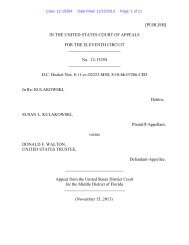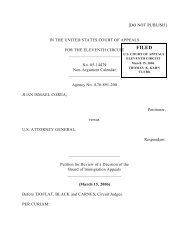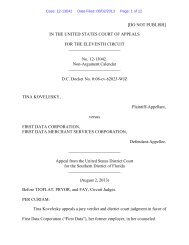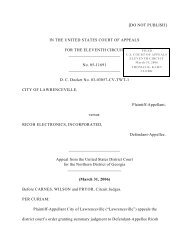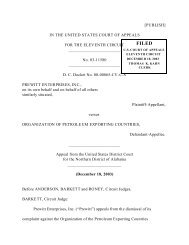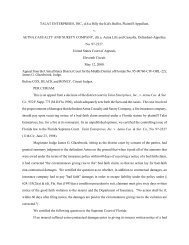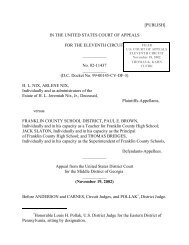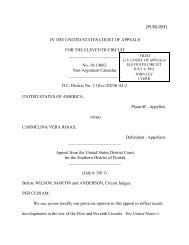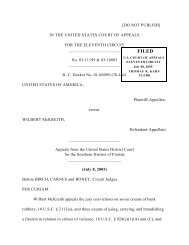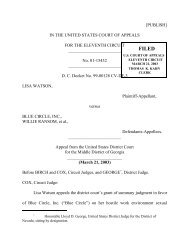USA v. Lazaro Antonio Lizano - Court of Appeals - 11th Circuit
USA v. Lazaro Antonio Lizano - Court of Appeals - 11th Circuit
USA v. Lazaro Antonio Lizano - Court of Appeals - 11th Circuit
You also want an ePaper? Increase the reach of your titles
YUMPU automatically turns print PDFs into web optimized ePapers that Google loves.
IN THE UNITED STATES COURT OF APPEALS<br />
UNITED STATES OF AMERICA,<br />
LAZARO ANTONIO LIZANO,<br />
FOR THE ELEVENTH CIRCUIT<br />
________________________<br />
No. 07-14096<br />
Non-Argument Calendar<br />
________________________<br />
D. C. Docket No. 07-60041-CR-JIC<br />
versus<br />
________________________<br />
Appeal from the United States District <strong>Court</strong><br />
for the Southern District <strong>of</strong> Florida<br />
_________________________<br />
(June 26, 2008)<br />
Before TJOFLAT, BLACK and PRYOR, <strong>Circuit</strong> Judges.<br />
PER CURIAM:<br />
[DO NOT PUBLISH]<br />
FILED<br />
U.S. COURT OF APPEALS<br />
ELEVENTH CIRCUIT<br />
JUNE 26, 2008<br />
THOMAS K. KAHN<br />
CLERK<br />
Plaintiff-Appellee,<br />
Defendant-Appellant.<br />
<strong>Lazaro</strong> <strong>Antonio</strong> <strong>Lizano</strong> appeals his sentence <strong>of</strong> imprisonment for 70 months<br />
for conspiracy to interfere with interstate commerce by means <strong>of</strong> robbery. See 18
U.S.C. § 1951(a). <strong>Lizano</strong>, the driver <strong>of</strong> a getaway car in connection with an armed<br />
robbery <strong>of</strong> an armored van, raises three issues on appeal. He first contends that<br />
the district court erred when it refused to reduce his sentence as a minor<br />
participant. Second, <strong>Lizano</strong> argues that the district court erred when it applied the<br />
firearm enhancement because it was not foreseeable that a firearm would be<br />
brandished during the robbery. Finally, <strong>Lizano</strong> contends that his sentence was<br />
substantively unreasonable. We affirm.<br />
I. MINOR ROLE ADJUSTMENT<br />
This <strong>Court</strong> reviews a determination <strong>of</strong> a defendant’s role in the <strong>of</strong>fense for<br />
clear error. United States v. Rodriguez De Varon, 175 F.3d 930, 937 (<strong>11th</strong> Cir.<br />
1999) (en banc) (citations omitted). A district court may apply a two-level<br />
reduction to a base <strong>of</strong>fense level “[i]f the defendant was a minor participant in any<br />
criminal activity.” U.S.S.G. § 3B1.2(b). A minor participant “is less culpable than<br />
most other participants, but . . . [his] role could not be described as minimal.”<br />
U.S.S.G. § 3B1.2 & cmt. (n.5). The defendant “always bears the burden <strong>of</strong><br />
proving a mitigating role in the <strong>of</strong>fense by a preponderance <strong>of</strong> the evidence.” De<br />
Varon, 175 F.3d at 937 (citations omitted).<br />
A district court employs a two-part analysis to decide whether a role<br />
reduction is warranted. First, the court measures the defendant’s role against the<br />
2
elevant conduct attributed to him in the calculation <strong>of</strong> his base <strong>of</strong>fense level. Id.<br />
at 940-41. Second, where the record evidence is sufficient, the court may compare<br />
the defendant’s conduct against that <strong>of</strong> any other participants in the relevant<br />
conduct. Id. at 944-95.<br />
<strong>Lizano</strong> was an integral part <strong>of</strong> the conspiracy to rob the armored truck. He<br />
participated in meetings planning the robbery, and his role as a getaway driver was<br />
crucial to the ultimate success or failure <strong>of</strong> the robbery. See id. at 940-41. That he<br />
did not actually rob the armored truck is <strong>of</strong> no moment. “A defendant is not<br />
automatically entitled to a minor role adjustment merely because he was somewhat<br />
less culpable than the other discernable parties.” Id. at 944. None <strong>of</strong> the<br />
participants in this robbery were minor; each played an essential role in the<br />
commission <strong>of</strong> the <strong>of</strong>fense. The district court did not clearly err when it refused<br />
to reduce <strong>Lizano</strong>’s base <strong>of</strong>fense level as a minor participant.<br />
II. FIREARM ENHANCEMENT<br />
“The district court’s interpretation <strong>of</strong> the sentencing guidelines is subject to<br />
de novo review on appeal, while its factual findings must be accepted unless<br />
clearly erroneous.” United States v. Jordi, 418 F.3d 1212 (<strong>11th</strong> Cir. 2005)<br />
(quoting United States v. Pompey, 17 F.3d 351, 353 (<strong>11th</strong> Cir. 1994)). If a firearm<br />
is “brandished or possessed” during a robbery, the court should increase the<br />
3
defendant’s base level <strong>of</strong>fense by five. U.S.S.G. § 2B3.1(b)(2)(C). When, as here,<br />
there is “jointly undertaken criminal activity . . . all reasonably foreseeable acts<br />
and omissions <strong>of</strong> others in furtherance <strong>of</strong> the jointly undertaken criminal activity,<br />
should be taken into account in calculating the defendant’s appropriate sentence.”<br />
United States v. Pringle, 350 F.3d 1172, 1175-76 (<strong>11th</strong> Cir. 2003) (quotation<br />
omitted). An act may be imputed from one participant in the criminal activity to<br />
another if the conduct was (1) “reasonably foreseeable,” and (2) “in furtherance <strong>of</strong><br />
the jointly undertaken criminal activity.” United States v. Gallo, 195 F.3d 1278,<br />
1281 (<strong>11th</strong> Cir. 1999); U.S.S.G. § 1B1.3(a)(1)(B).<br />
The government must prove “reasonable foreseeability” by a preponderance<br />
<strong>of</strong> the evidence. United States v. Cover, 199 F.3d 1270, 1274 (<strong>11th</strong> Cir. 2000).<br />
The government need not prove that the defendant expressly agreed to the acts <strong>of</strong><br />
the other participants. Id. at 1275; see also U.S.S.G. § 1B1.3, cmt. (n.2). Instead,<br />
“an act is reasonably foreseeable if it is a necessary or natural consequence <strong>of</strong> the<br />
unlawful agreement.” Cover, 199 F.3d at 1275 (internal punctuation and<br />
quotations omitted).<br />
It was reasonably foreseeable that a firearm would be brandished or<br />
possessed during the robbery <strong>of</strong> the armored truck. <strong>Lizano</strong> participated in<br />
planning meetings with the other participants before the robbery and knew about<br />
4
pre-robbery surveillance. Because it is well known that armored trucks are<br />
protected by armed guards, <strong>Lizano</strong> either knew or should have known that the<br />
robbery <strong>of</strong> an armored truck would necessarily include firearms. The application<br />
<strong>of</strong> the firearm enhancement by the district court was not clearly erroneous.<br />
III. SUBSTANTIVE REASONABLENESS OF SENTENCE<br />
This <strong>Court</strong> may review a sentence for procedural or substantive<br />
reasonableness. Gall v. United States, 552 U.S. ___, ___, 128 S. Ct. 586, 597<br />
(2007). The substantive reasonableness <strong>of</strong> a sentence is reviewed for an abuse <strong>of</strong><br />
discretion. Id. The review for substantive reasonableness involves an<br />
examination <strong>of</strong> the totality <strong>of</strong> the circumstances, including an inquiry into whether<br />
the statutory factors, 18 U.S.C. § 3553(a), support the challenged sentence. Id. at<br />
___, 128 S. Ct. at 597-600. We defer to the judgment <strong>of</strong> the district court in the<br />
weight given to the factors in section 3553(a) unless the district court has made “a<br />
clear error <strong>of</strong> judgment” and has imposed “a sentence that lies outside the range <strong>of</strong><br />
reasonable sentences dictated by the facts <strong>of</strong> the case.” United States v. McBride,<br />
511 F.3d 1293, 1297-98 (<strong>11th</strong> Cir. 2007) (citations omitted).<br />
<strong>Lizano</strong> has not established that his sentence is unreasonable. The sentence<br />
imposed was the lowest end <strong>of</strong> the advisory guideline range. The district court<br />
reasonably determined that this sentence was not greater than necessary to achieve<br />
5
the statutory purposes <strong>of</strong> sentencing.<br />
IV. CONCLUSION<br />
For these reasons, the sentence imposed by the district court is<br />
AFFIRMED.<br />
6



